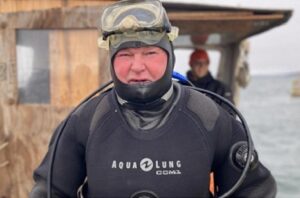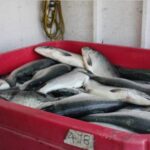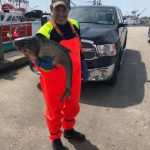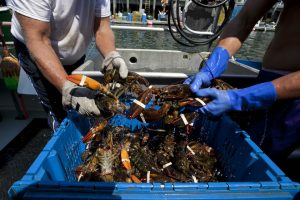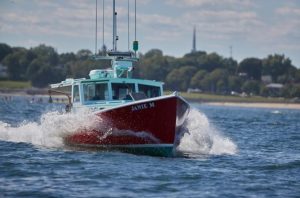Monthly Archives: June 2016
What a surprise! Fishermen can catch grass carp, but government scientists can’t!
 Despite Quebec’s investment of $1.7 million to tackle a possible grass carp invasion, scientists have yet to locate any specimens themselves. Quebec’s Forests, Wildlife and Parks Ministry was quick to roll out a plan to combat the invasive species after two fishermen in the Lanaudière region caught a 29-kilogram grass carp in the St. Lawrence River May 27. Government scientists’ subsequent fishing expeditions have taken place in the Contrecœur area, about 60 kilometres northeast of Montreal. Tuesday, the ministry announced they have come up empty-handed. At this stage, laboratory tests are underway to determine the presence of grass carp DNA in the St. Lawrence River, sampling water from different areas. Those results will be available at the beginning of July. The grass carp is a type of Asian carp. The one that was caught in the St. Lawrence River was estimated to be between 15 and 30 years old. link 10:17
Despite Quebec’s investment of $1.7 million to tackle a possible grass carp invasion, scientists have yet to locate any specimens themselves. Quebec’s Forests, Wildlife and Parks Ministry was quick to roll out a plan to combat the invasive species after two fishermen in the Lanaudière region caught a 29-kilogram grass carp in the St. Lawrence River May 27. Government scientists’ subsequent fishing expeditions have taken place in the Contrecœur area, about 60 kilometres northeast of Montreal. Tuesday, the ministry announced they have come up empty-handed. At this stage, laboratory tests are underway to determine the presence of grass carp DNA in the St. Lawrence River, sampling water from different areas. Those results will be available at the beginning of July. The grass carp is a type of Asian carp. The one that was caught in the St. Lawrence River was estimated to be between 15 and 30 years old. link 10:17
Brexit flotilla: Bob Geldof and Nigel Farage have massive horn-off in the Thames
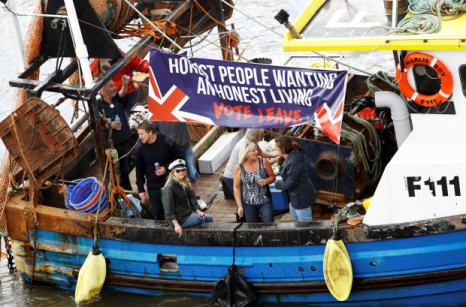 In the Leave slipstream: Ukip’s Nigel Farage, and a navy of fishermen on board for Brexit who sailed up the river with him in a parade of up to 60 trawlers. Urging Remain, musician Sir Bob Geldof is giving it back to him on a boat of ‘In’ supporters holding pro-EU banners in protest and blaring out ‘In With The In Crowd’. As they tried to outdo each other with their foghorns, Brexiters soaking the Bremainers with their hoses as they passed. Fishermen campaigning for Brexit argue their industry is being damaged by European Union quotas. ‘The governing principle of the common fisheries policy is that of ‘equal access to a common resource’,’ Farage said. ‘Fish stock that should be within the UK’s internationally-recognised territorial waters is now shared with our European partners. This has led to a 60% drop in oversized landings and the loss of tens of thousands of jobs in our industry.’ Lots of images, and video streams, click here 09:04
In the Leave slipstream: Ukip’s Nigel Farage, and a navy of fishermen on board for Brexit who sailed up the river with him in a parade of up to 60 trawlers. Urging Remain, musician Sir Bob Geldof is giving it back to him on a boat of ‘In’ supporters holding pro-EU banners in protest and blaring out ‘In With The In Crowd’. As they tried to outdo each other with their foghorns, Brexiters soaking the Bremainers with their hoses as they passed. Fishermen campaigning for Brexit argue their industry is being damaged by European Union quotas. ‘The governing principle of the common fisheries policy is that of ‘equal access to a common resource’,’ Farage said. ‘Fish stock that should be within the UK’s internationally-recognised territorial waters is now shared with our European partners. This has led to a 60% drop in oversized landings and the loss of tens of thousands of jobs in our industry.’ Lots of images, and video streams, click here 09:04Judge requests additional briefs and memoranda concerning at-sea monitoring lawsuit
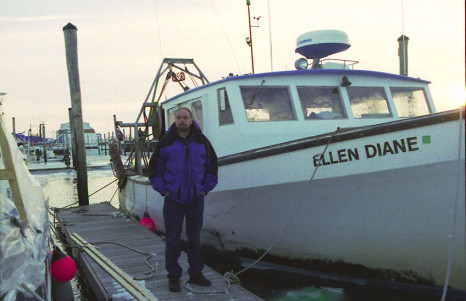 The final judgment in New Hampshire fisherman David Goethel’s federal lawsuit against NOAA Fisheries concerning at-sea monitoring will be further delayed after the judge in the case requested additional briefs and memoranda from both sides. “In consideration of the parties’ cross motions for summary judgment and conducting the attending legal research, the court has identified points, authorities and (to some extent) arguments that were unfortunately not cited or raised by the parties’ legal memoranda,” U.S. District Court Judge Joseph Laplante wrote in his procedural order. Prior to ordering the supplemental filings, Laplante, who sits in U.S. District Court in Concord, New Hampshire, held a June 9 conference call with attorneys to discuss “whether, and the extent to which, any delay caused by additional briefing would increase, extend or intensify any claimed economic hardship” from the federal mandate shifting the costs of at-sea monitoring to the industry. Read the rest here 21:05
The final judgment in New Hampshire fisherman David Goethel’s federal lawsuit against NOAA Fisheries concerning at-sea monitoring will be further delayed after the judge in the case requested additional briefs and memoranda from both sides. “In consideration of the parties’ cross motions for summary judgment and conducting the attending legal research, the court has identified points, authorities and (to some extent) arguments that were unfortunately not cited or raised by the parties’ legal memoranda,” U.S. District Court Judge Joseph Laplante wrote in his procedural order. Prior to ordering the supplemental filings, Laplante, who sits in U.S. District Court in Concord, New Hampshire, held a June 9 conference call with attorneys to discuss “whether, and the extent to which, any delay caused by additional briefing would increase, extend or intensify any claimed economic hardship” from the federal mandate shifting the costs of at-sea monitoring to the industry. Read the rest here 21:05
Connecticut lawmakers call on inspector general to investigate fishing regulations
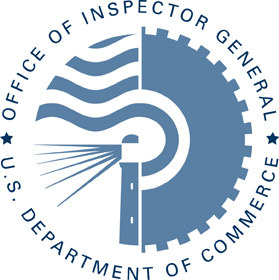 U.S. Sens. Richard Blumenthal and Chris Murphy, both D-Conn., along with U.S. Rep. Joe Courtney, D-Second District, on Tuesday called on the inspector general of the Department of Commerce to investigate what they call an inequity in regulations that puts New England fishermen at a disadvantage. “We write to raise a growing concern of our constituents in the fishing industry who are facing extreme economic hardship related to the structure of fisheries management across the Northeast and mid-Atlantic,” wrote Blumenthal, Murphy and Courtney. “On several occasions during town halls and meetings in Connecticut with many of the fishermen who operate in the state, we have repeatedly heard concerns that black sea bass, summer flounder, and scup have migrated northward, but the state-by-state allocations for these species still reflect historical numbers when they were in greater abundance in the mid-Atlantic,” the lawmakers wrote. Read the rest here 18:53
U.S. Sens. Richard Blumenthal and Chris Murphy, both D-Conn., along with U.S. Rep. Joe Courtney, D-Second District, on Tuesday called on the inspector general of the Department of Commerce to investigate what they call an inequity in regulations that puts New England fishermen at a disadvantage. “We write to raise a growing concern of our constituents in the fishing industry who are facing extreme economic hardship related to the structure of fisheries management across the Northeast and mid-Atlantic,” wrote Blumenthal, Murphy and Courtney. “On several occasions during town halls and meetings in Connecticut with many of the fishermen who operate in the state, we have repeatedly heard concerns that black sea bass, summer flounder, and scup have migrated northward, but the state-by-state allocations for these species still reflect historical numbers when they were in greater abundance in the mid-Atlantic,” the lawmakers wrote. Read the rest here 18:53
Offshore Communication: Wicked Tuna Captain Dave Carraro Relies on Globalstar
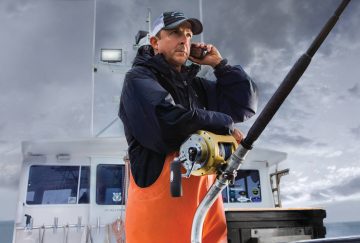 When it comes to fishing, Captain Dave Carraro of FV Tuna.com knows a thing or two, having run a successful charter business for the past 37 years, and is now a leading competitor and previous winner of the television show Wicked Tuna. Carraro keeps a busy schedule off land, even flying as a pilot for JetBlue when he isn’t fishing. “Sometimes we are out on the water for four to five days in a row, fishing around the clock, which can be very strenuous, both physically and mentally. Not to mention the weather can be unpredictable and we can be fighting fish in very, very rough seas,” Carraro said. While there may be unknowns relative to weather and fish cooperating, one thing Carraro doesn’t worry about is reliable communication, Read the rest here 16:34
When it comes to fishing, Captain Dave Carraro of FV Tuna.com knows a thing or two, having run a successful charter business for the past 37 years, and is now a leading competitor and previous winner of the television show Wicked Tuna. Carraro keeps a busy schedule off land, even flying as a pilot for JetBlue when he isn’t fishing. “Sometimes we are out on the water for four to five days in a row, fishing around the clock, which can be very strenuous, both physically and mentally. Not to mention the weather can be unpredictable and we can be fighting fish in very, very rough seas,” Carraro said. While there may be unknowns relative to weather and fish cooperating, one thing Carraro doesn’t worry about is reliable communication, Read the rest here 16:34Fish plant workers: stop gutting West Coast fishery
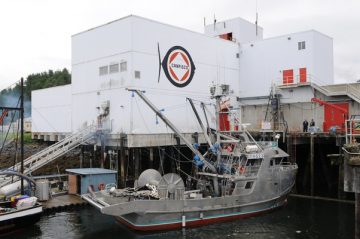 Specifically, United Fishermen and Allied Workers’ Union, were lobbying the parliamentary standing committee on fisheries and oceans to break what they describe as a monopoly held by Jim Pattison and his Canadian Fishing Co. (Canfisco) on fishing fleets, quotas and licences. They also want the government to restrict the practice of sending fish caught in B.C. for secondary processing to the U.S. or China. “The processing of fish that is owned by the people of Canada should benefit the people of Canada,” Arnie Nagey, a Haida citizen who worked as a millwright in Canfisco’s Prince Rupert cannery, told the committee June 7. “The boats should be owned by the people who fish them, not the company.” North coast fish plant workers want adjacency rules, which would require fish caught in Canadian waters to be processed in Canada. But that would likely trigger challenges under the North American Free Trade Agreement, said Rob Morley, Canfisco’s vice-president of product and corporate development. Read the rest here 13:37
Specifically, United Fishermen and Allied Workers’ Union, were lobbying the parliamentary standing committee on fisheries and oceans to break what they describe as a monopoly held by Jim Pattison and his Canadian Fishing Co. (Canfisco) on fishing fleets, quotas and licences. They also want the government to restrict the practice of sending fish caught in B.C. for secondary processing to the U.S. or China. “The processing of fish that is owned by the people of Canada should benefit the people of Canada,” Arnie Nagey, a Haida citizen who worked as a millwright in Canfisco’s Prince Rupert cannery, told the committee June 7. “The boats should be owned by the people who fish them, not the company.” North coast fish plant workers want adjacency rules, which would require fish caught in Canadian waters to be processed in Canada. But that would likely trigger challenges under the North American Free Trade Agreement, said Rob Morley, Canfisco’s vice-president of product and corporate development. Read the rest here 13:37
Yes, Copper River Seafoods just posted a preseason price. And yes, it’s encouraging.
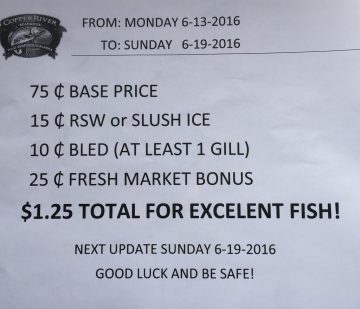 Up to $1.25 for “Excelent Fish” caught this week, going out fresh to a market that is hungry for the product, says CRS. Company says it intends to post a price every Sunday for the week ahead. Copper River Seafoods Bristol Bay manager Vojtech Novak posted a price for this week’s sockeye catch, and says he intends to post a weekly price every Sunday. It’s an unusual step for one of Bristol Bay’s buyers to list a price before the catch comes in. “You know, the owner of our company was a fisherman, and he feels like he’s still a fisherman,” said Novak. “His dream was always to know the price before going fishing, and we’re trying to work on that and give our fishermen a price. Before they go fish, they know what they’re getting.” Read the rest here 13:10
Up to $1.25 for “Excelent Fish” caught this week, going out fresh to a market that is hungry for the product, says CRS. Company says it intends to post a price every Sunday for the week ahead. Copper River Seafoods Bristol Bay manager Vojtech Novak posted a price for this week’s sockeye catch, and says he intends to post a weekly price every Sunday. It’s an unusual step for one of Bristol Bay’s buyers to list a price before the catch comes in. “You know, the owner of our company was a fisherman, and he feels like he’s still a fisherman,” said Novak. “His dream was always to know the price before going fishing, and we’re trying to work on that and give our fishermen a price. Before they go fish, they know what they’re getting.” Read the rest here 13:10
Get ready for some awesome wake — it’s lobster boat racing season!
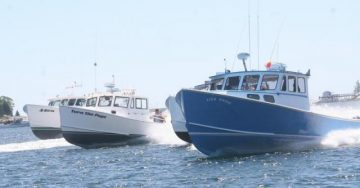 Spectators and lobstermen alike are getting revved up for Boothbay Harbor’s Charlie Begin Memorial Lobster Boat Races set for Saturday, June 18, at 10 a.m. You’re picking up “good vibrations” already, aren’t you? This year marks the 31st year of lobster boat races in Boothbay Harbor. The race course runs in front of Tumbler Island toward the finish line at the Maine State Aquarium. Event organizer Ashlee Lowery says she expects 60, yep, 6-0, boats this year — some from way up north and over the Maine border. “I’ve been talking with a couple of boats from Canada and they are looking forward to coming to Boothbay Harbor to show off — and create havoc just for fun,” Lowery said. “I hear these boats are really fast — 70 mph — but they are two-seaters with open hulls and big engines. Our (Maine) rules say the boats must be working lobster boats.” Read the story here 12:22
Spectators and lobstermen alike are getting revved up for Boothbay Harbor’s Charlie Begin Memorial Lobster Boat Races set for Saturday, June 18, at 10 a.m. You’re picking up “good vibrations” already, aren’t you? This year marks the 31st year of lobster boat races in Boothbay Harbor. The race course runs in front of Tumbler Island toward the finish line at the Maine State Aquarium. Event organizer Ashlee Lowery says she expects 60, yep, 6-0, boats this year — some from way up north and over the Maine border. “I’ve been talking with a couple of boats from Canada and they are looking forward to coming to Boothbay Harbor to show off — and create havoc just for fun,” Lowery said. “I hear these boats are really fast — 70 mph — but they are two-seaters with open hulls and big engines. Our (Maine) rules say the boats must be working lobster boats.” Read the story here 12:22
P.E.I. lobster fishermen hope higher prices make up for lower catches
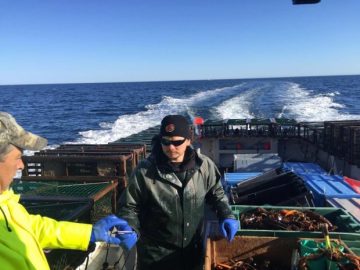 With prices currently at $6.50 for canners and $7 for markets, P.E.I. lobster fishermen are hoping to ride out a spring of bad weather and lower catches. “Prices have been fairly good, catches are down quite a bit and the weather has been just terrible,” said Craig Avery, president of the P.E.I. Fishermen’s Association, who stayed on shore Monday for the third time this season. “It’s been a tough, tough year. The price, whatever we’re getting for them, it’s well-earned,” he added. About a thousand Island fishermen are currently on the water, including 630 along the North Shore from North Cape to East Point and 340 on the south shore from East Point to Victoria, P.E.I.. Catches are down all along P.E.I.’s North Shore, called Lobster Fishing Area 24, according to what Avery is hearing. He fishes out of Northport, near Alberton, P.E.I., and estimates his catch will be down about 25 per cent from last season. Read the rest here 09:56
With prices currently at $6.50 for canners and $7 for markets, P.E.I. lobster fishermen are hoping to ride out a spring of bad weather and lower catches. “Prices have been fairly good, catches are down quite a bit and the weather has been just terrible,” said Craig Avery, president of the P.E.I. Fishermen’s Association, who stayed on shore Monday for the third time this season. “It’s been a tough, tough year. The price, whatever we’re getting for them, it’s well-earned,” he added. About a thousand Island fishermen are currently on the water, including 630 along the North Shore from North Cape to East Point and 340 on the south shore from East Point to Victoria, P.E.I.. Catches are down all along P.E.I.’s North Shore, called Lobster Fishing Area 24, according to what Avery is hearing. He fishes out of Northport, near Alberton, P.E.I., and estimates his catch will be down about 25 per cent from last season. Read the rest here 09:56
Commercial Dungeness fishery opens Wednesday in Southeast Alaska
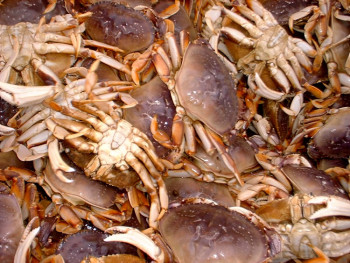 The summer commercial Dungeness crab fishery in Southeast opens Wednesday at 8 a.m. After a record season two years ago, and an average catch in last season, officials are anticipating more crabbers on the water this week. Stuart DeWitt has been commercial fishing for dungy for close to five years. He’s one of a few fishermen in Haines that drops pots before starting the commercial salmon season. According to Alaska Department of Fish and Game, Dungeness crab went for an average of $2.95 a pound during the 2014-2015 season. Last season, the average was $3.02 per pound, an all-time high since the mid ‘80s when the department started tracking prices. The 2014-15 season was a banner harvest, with around $14 million worth of crab garnered, or around 5 million pounds. Last season yielded about 3.2 million pounds. Audio report, read the rest here 08:56
The summer commercial Dungeness crab fishery in Southeast opens Wednesday at 8 a.m. After a record season two years ago, and an average catch in last season, officials are anticipating more crabbers on the water this week. Stuart DeWitt has been commercial fishing for dungy for close to five years. He’s one of a few fishermen in Haines that drops pots before starting the commercial salmon season. According to Alaska Department of Fish and Game, Dungeness crab went for an average of $2.95 a pound during the 2014-2015 season. Last season, the average was $3.02 per pound, an all-time high since the mid ‘80s when the department started tracking prices. The 2014-15 season was a banner harvest, with around $14 million worth of crab garnered, or around 5 million pounds. Last season yielded about 3.2 million pounds. Audio report, read the rest here 08:56
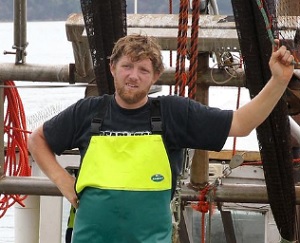
Catch Shares New South Wales Style – Half the Small Boat Fishermen will disappear
MORE than half of the Coast’s 100 commercial fishers are expected to be cut adrift after the state government released its industry reforms last week. Dane Van Der Neut, president of the NSW Wild Caught Fishers Coalition, said the worst fears of local commercial fishers were realised in the Baird Government’s bid to overhaul the $90 million industry. “We’ll now lose over half our fleet, from Tuggerah Lake to the Hawkesbury, because the government wants to corporatise the industry, make all shares equal, and price out the smaller operators,” Patonga-based Mr Van Der Neut said. Terrigal state Liberal MP Adam Crouch hailed the changes as a “new era” for commercial fishing. Read the rest here 08:16
Asian carp in the St-Lawrence threatens Quebec’s fishing industry
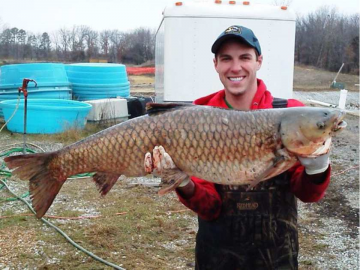 If you’ve seen the videos of boaters laughing uproariously as their motors startle giant Asian carp that leap high in the air and even into their boats, you might think it’s fun news that a 29-kilogram Asian carp was recently fished out of the St-Lawrence River. It’s not. The discovery of a single grass carp, one of four Asian carp species that have invaded several waterways in the United States in recent decades, near Contrecoeur last month could spell disaster for other fish, waterfowl and various species in the St-Lawrence River, and the waterways connected to it, as well as Quebec’s fishing industry. Here is a primer on Asian carp and why they’re so worrisome. Read the rest here 20:43
If you’ve seen the videos of boaters laughing uproariously as their motors startle giant Asian carp that leap high in the air and even into their boats, you might think it’s fun news that a 29-kilogram Asian carp was recently fished out of the St-Lawrence River. It’s not. The discovery of a single grass carp, one of four Asian carp species that have invaded several waterways in the United States in recent decades, near Contrecoeur last month could spell disaster for other fish, waterfowl and various species in the St-Lawrence River, and the waterways connected to it, as well as Quebec’s fishing industry. Here is a primer on Asian carp and why they’re so worrisome. Read the rest here 20:43
Efforts to launch local processors in two Bristol Bay communities may finally be coming to fruition.
 For decades, many of the processors in Bristol Bay have been large companies, with offices in Washington and parent companies in foreign countries. But two small communities are developing locally-owned processing plants. Bristol Bay’s fishing communities have long been dependent on the companies that turn raw fish into a sell-able product and get it shipped out of the bay. The communities of Port Heiden and Levelock want to take on that role themselves and – hopefully – keep more of the decisions, and the benefits, local. “We wanted to start a locally tribally owned processing plant so that we could create a longer season for our fishermen, also to have our fishermen fish closer to home so they don’t have to go all the way up to Ugashik to fish, and to provide them with a higher price for their fish because we’ll be doing direct marketing and have a higher quality product,” she said. “That will mean more jobs and more pay for the fishermen.” Audio, read the rest here 19:38
For decades, many of the processors in Bristol Bay have been large companies, with offices in Washington and parent companies in foreign countries. But two small communities are developing locally-owned processing plants. Bristol Bay’s fishing communities have long been dependent on the companies that turn raw fish into a sell-able product and get it shipped out of the bay. The communities of Port Heiden and Levelock want to take on that role themselves and – hopefully – keep more of the decisions, and the benefits, local. “We wanted to start a locally tribally owned processing plant so that we could create a longer season for our fishermen, also to have our fishermen fish closer to home so they don’t have to go all the way up to Ugashik to fish, and to provide them with a higher price for their fish because we’ll be doing direct marketing and have a higher quality product,” she said. “That will mean more jobs and more pay for the fishermen.” Audio, read the rest here 19:38
Belford Seafood Co-op struggles to stay afloat following damaging fire
 The general manager of the Belford Seafood Co-op says the business is doing all that it can to stay open following a fire that destroyed the second floor. The fire on Port Monmouth Road over Memorial Day weekend destroyed the co-op’s ice machines, but did not damage the main building. The retail market is still open for business, and local fisherman are still bringing in their catches. General manager Joe Branin tells News 12 New Jersey that the co-op has been shipping in ice from several vendors, including ones in Atlantic Highlands and Newark. This is so they can keep the thousands of pound of fish that are brought in from spoiling. Video, read the rest here 18:50
The general manager of the Belford Seafood Co-op says the business is doing all that it can to stay open following a fire that destroyed the second floor. The fire on Port Monmouth Road over Memorial Day weekend destroyed the co-op’s ice machines, but did not damage the main building. The retail market is still open for business, and local fisherman are still bringing in their catches. General manager Joe Branin tells News 12 New Jersey that the co-op has been shipping in ice from several vendors, including ones in Atlantic Highlands and Newark. This is so they can keep the thousands of pound of fish that are brought in from spoiling. Video, read the rest here 18:50
California’s offshore seamounts at risk of being closed
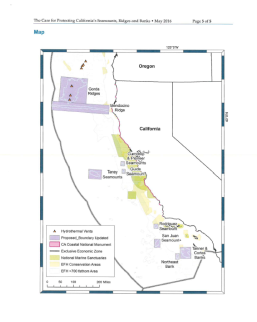 It has long been rumored that conservation groups were hoping to have the President use the Antiquities Act to designate Tanner and Cortes banks as National Marine Monuments. Finally, this rumor has been put on paper and its reach is far more than just the two areas mentioned above. The areas in grey below are those being proposed for Monument designation. Unlike the substantial public process that accompanies creation of a National Marine Sanctuary, designation of an area as a National Marine Monument is done outside the public eye – under the Antiquities Act. The Antiquities Act (54 USC §320301 et seq) empowers the President to, “in the President’s discretion, declare by public proclamation historic landmarks, historic and prehistoric structures, and other objects of historic or scientific interest that are situated on land owned or controlled by the Federal Government to be national monuments.” Read the rest here 17:09
It has long been rumored that conservation groups were hoping to have the President use the Antiquities Act to designate Tanner and Cortes banks as National Marine Monuments. Finally, this rumor has been put on paper and its reach is far more than just the two areas mentioned above. The areas in grey below are those being proposed for Monument designation. Unlike the substantial public process that accompanies creation of a National Marine Sanctuary, designation of an area as a National Marine Monument is done outside the public eye – under the Antiquities Act. The Antiquities Act (54 USC §320301 et seq) empowers the President to, “in the President’s discretion, declare by public proclamation historic landmarks, historic and prehistoric structures, and other objects of historic or scientific interest that are situated on land owned or controlled by the Federal Government to be national monuments.” Read the rest here 17:09
The Mid-Atlantic Fishery Management Council is in session in Newark, DE Jun 13-16 2016
 The public is invited to attend the Mid-Atlantic Fishery Management Council’s April meeting to be held at the Courtyard Marriott Newark Montauk Yacht Club, Council Meeting Agenda, For online access to the meeting, enter as a guest Click here 13:40
The public is invited to attend the Mid-Atlantic Fishery Management Council’s April meeting to be held at the Courtyard Marriott Newark Montauk Yacht Club, Council Meeting Agenda, For online access to the meeting, enter as a guest Click here 13:40
The northern shrimp problem — a brief history, Russell Wangersky
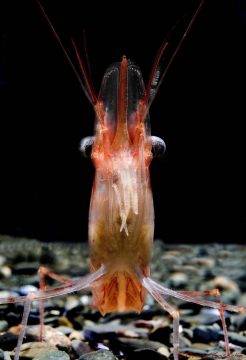 Perhaps it’s fitting this battle is over a creature that’s a hermaphrodite — because the ongoing battle over northern shrimp hinges on a fundamental change. The financial-valuable northern shrimp, Pandalus borealis, develops as a male, lives four to seven years as that sex, before going through an inversion and becoming female. Right now, a federally established panel is asking a crucial question: should the last players to enter the shrimp fishery — Newfoundland and Labrador vessels closest to the resource — be the first ones edged out as the biomass shrinks and the total allowable catch shrinks with it? So think of this as something of a shrimp primer. Read the rest here 10:39
Perhaps it’s fitting this battle is over a creature that’s a hermaphrodite — because the ongoing battle over northern shrimp hinges on a fundamental change. The financial-valuable northern shrimp, Pandalus borealis, develops as a male, lives four to seven years as that sex, before going through an inversion and becoming female. Right now, a federally established panel is asking a crucial question: should the last players to enter the shrimp fishery — Newfoundland and Labrador vessels closest to the resource — be the first ones edged out as the biomass shrinks and the total allowable catch shrinks with it? So think of this as something of a shrimp primer. Read the rest here 10:39
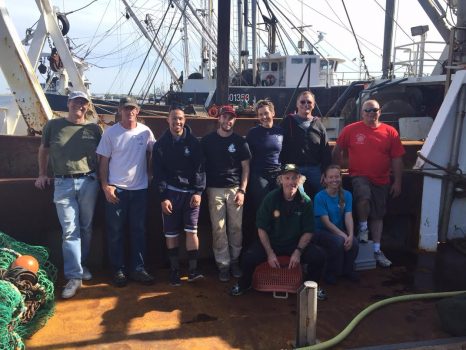
Gloucester – Fishermen, scientists to assess stock
The most incendiary divide between groundfishermen and fishing regulators in the past two years has been the discrepancy between what NOAA Fisheries says its stock assessments show and what fishermen are seeing on the water. The groundfish assessments by the National Oceanic and Atmospheric Administration — particularly for the iconic Gulf of Maine cod stock and certain flounders — have been uniformly dire, leading to the virtual shuttering of cod fishing in the Gulf of Maine and scant quotas for other species. Fishermen — including commercial groundfishermen, charter captains and even lobstermen — paint a very different portrait of what they are seeing on a daily basis: cod, cod everywhere, and not a one they can catch. On June 20, the city’s Economic Development and Industrial Corporation and fishing stakeholders will host a presentation by a team of University of Massachusetts scientists on their current findings and methodology for fish population counting in the Gulf of Maine. Read the rest here 10:09
South Atlantic Fishery Management Council meeting June 13-17, 2016 Cocoa Beach FL
 The public is invited to attend the South Atlantic Fishery Management Council to be held in Cocoa Beach FL at the Hilton Cocoa Beach Oceanfront . Read the Meeting Agenda Click here, Briefing Book – June 2016 Council Meeting Click here Webinar Registration: Listen Live, Click here Additional info, click here 22:54
The public is invited to attend the South Atlantic Fishery Management Council to be held in Cocoa Beach FL at the Hilton Cocoa Beach Oceanfront . Read the Meeting Agenda Click here, Briefing Book – June 2016 Council Meeting Click here Webinar Registration: Listen Live, Click here Additional info, click here 22:54
Peterhead: Scottish fishermen see benefits of cutting free from EU’s net
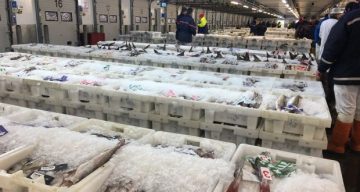 At 7.30am on a fresh weekday in northeast Scotland, Peterhead fish market is in full swing. Agents representing local fishermen reel off latest prices for haddock, hake and halibut at the top of their voices, like gruff bingo callers. Buyers, wrapped up in heavy coats, cast a critical eye over plastic boxes filled with catch fresh from the vast North Sea. Peterhead is Europe’s largest fish market. After many difficult years, business is slowly improving. The buyers’ stubbed pens recorded sales of £180 million last year, and plans are afoot for a £49 million (€62 million) expansion of the sprawling port funded, in part, by European Union grants. But there is little love for the EU among Peterhead’s fishermen, many of whom blame Brussels for imposing inflexible regulations and failing to protect their industry from foreign fleets. Read the rest here 21:41
At 7.30am on a fresh weekday in northeast Scotland, Peterhead fish market is in full swing. Agents representing local fishermen reel off latest prices for haddock, hake and halibut at the top of their voices, like gruff bingo callers. Buyers, wrapped up in heavy coats, cast a critical eye over plastic boxes filled with catch fresh from the vast North Sea. Peterhead is Europe’s largest fish market. After many difficult years, business is slowly improving. The buyers’ stubbed pens recorded sales of £180 million last year, and plans are afoot for a £49 million (€62 million) expansion of the sprawling port funded, in part, by European Union grants. But there is little love for the EU among Peterhead’s fishermen, many of whom blame Brussels for imposing inflexible regulations and failing to protect their industry from foreign fleets. Read the rest here 21:41
Long Island a Possible ‘Breeding Ground’ For Great White Sharks
 Ever since the blood-curdling screams of an ill-fated skinny dipper, who met her famous demise in the opening scene of “Jaws,” generations of beach-goers have approached the water with bone-chilling trepidation. Now, a leading shark research team has said it suspects Long Island might be a breeding ground for great whites and has launched a tagging expedition to be able to determine potential birthing sites. According to OCEARCH Chief Operating Officer Fernanda Ubatuba — OCEARCH is a nonprofit organization dedicated to shark research — if you look at a global shark tracker, five mature female great white sharks have been tagged in the past three to four years, and it seems that “there is certain activity in that region.” Great white sharks, she said, travel from Florida to Canada, “and you can see their activity sometimes overlaps around Long Island.” Read the rest here 17:35
Ever since the blood-curdling screams of an ill-fated skinny dipper, who met her famous demise in the opening scene of “Jaws,” generations of beach-goers have approached the water with bone-chilling trepidation. Now, a leading shark research team has said it suspects Long Island might be a breeding ground for great whites and has launched a tagging expedition to be able to determine potential birthing sites. According to OCEARCH Chief Operating Officer Fernanda Ubatuba — OCEARCH is a nonprofit organization dedicated to shark research — if you look at a global shark tracker, five mature female great white sharks have been tagged in the past three to four years, and it seems that “there is certain activity in that region.” Great white sharks, she said, travel from Florida to Canada, “and you can see their activity sometimes overlaps around Long Island.” Read the rest here 17:35
The Shellfish Wars: Lobsters, Shoalies, Olys, Atlantics and Pacifics vie for supremacy
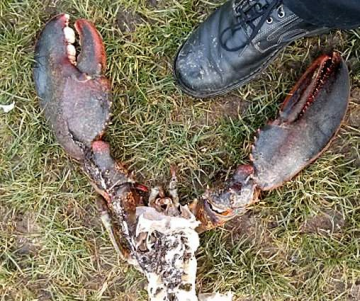 If you’ve ever idly wondered why lobsters are such a big deal in New England and Maritime Canada but haven’t gained a claw-hold at our similar latitude in the Pacific, you’re not unique — the question has come up since at least the 1880s. Among many instances of European-Americans endeavoring to reconfigure the West Coast’s animals, plants and landforms to our liking, efforts to establish lobsters here have to be counted as a failure … so far. In 1888 two shipments totaling 565 adult lobsters and 104,000 fry were planted off the Pacific coast between Monterey Bay and the Strait of Juan Fuca. “What the result of this will be can be conjectured, but cannot be definitely determined until after the lapse of sufficient time to give the lobsters an opportunity to grow and multiply,” J.W. Collins told Congress in his landmark “Report on the Fisheries of the Pacific Coast of the United States.” Already naturally providing such a delicious bounty of seafood options, the natural spirits of the North Pacific must have concluded this attempt was human hubris of the worst sort, and slapped it down. But we didn’t give up. Read the rest here 15:06
If you’ve ever idly wondered why lobsters are such a big deal in New England and Maritime Canada but haven’t gained a claw-hold at our similar latitude in the Pacific, you’re not unique — the question has come up since at least the 1880s. Among many instances of European-Americans endeavoring to reconfigure the West Coast’s animals, plants and landforms to our liking, efforts to establish lobsters here have to be counted as a failure … so far. In 1888 two shipments totaling 565 adult lobsters and 104,000 fry were planted off the Pacific coast between Monterey Bay and the Strait of Juan Fuca. “What the result of this will be can be conjectured, but cannot be definitely determined until after the lapse of sufficient time to give the lobsters an opportunity to grow and multiply,” J.W. Collins told Congress in his landmark “Report on the Fisheries of the Pacific Coast of the United States.” Already naturally providing such a delicious bounty of seafood options, the natural spirits of the North Pacific must have concluded this attempt was human hubris of the worst sort, and slapped it down. But we didn’t give up. Read the rest here 15:06

River Herring spawn in NY tributary for 1st time in 85 years
A few days after a long-abandoned industrial dam was removed from the mouth of a Hudson River tributary this spring, hundreds of river herring swarmed up into the shallow waters to spawn for the first time in 85 years. The removal of the rusted steel dam on the Wynants Kill near Albany was the first of what ecologists hope will be many barriers removed in Hudson tributaries to restore spawning habitat for herring and other ocean-going species that have been devastated by habitat loss, pollution and overfishing. “There are more than 1,500 dams in the Hudson estuary watershed, most of them no longer in use,” said Frances Dunwell, coordinator of the state Department of Environmental Conservation’s Hudson River Estuary Program. “One of the key items on our to-do list by 2020 is to remove as many of these barriers as possible.” Read the rest here 12:01
1 in 30 million: rare yellow lobster caught in Bonavista Bay
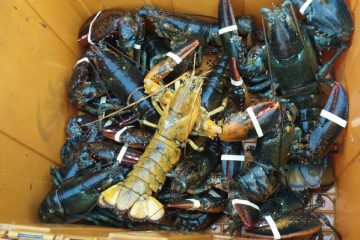 An extremely rare yellow lobster was hauled up in Newman Sound Friday, and visitors to Terra Nova National Park are invited to take a peek. Sandy Turner, who fishes for Happy Adventure Sea Products, said the lobster is female, weighing 1 ¼ pounds. The crew — Turner, Bon Squire and Edward Powell — donated it to Terra Nova, where it is now at the park’s interpretation centre. “When we hauled up the pot, we got a shock seeing a yellow lobster sitting in the pot,” she said. “Fishing for 25 years and never seen a lobster that colour before.” According to the University of Maine, the odds of catching a yellow lobster is one in 30 million. That’s six times as rare as a blue lobster. Link 09:52
An extremely rare yellow lobster was hauled up in Newman Sound Friday, and visitors to Terra Nova National Park are invited to take a peek. Sandy Turner, who fishes for Happy Adventure Sea Products, said the lobster is female, weighing 1 ¼ pounds. The crew — Turner, Bon Squire and Edward Powell — donated it to Terra Nova, where it is now at the park’s interpretation centre. “When we hauled up the pot, we got a shock seeing a yellow lobster sitting in the pot,” she said. “Fishing for 25 years and never seen a lobster that colour before.” According to the University of Maine, the odds of catching a yellow lobster is one in 30 million. That’s six times as rare as a blue lobster. Link 09:52
Kevin Kelly – scallop counter for the Maine Department of Marine Resources
 Kevin Kelly has been at the Department of Marine Resources for almost 32 years, working on the groundfish and lobster fisheries before being assigned to scallops about nine years ago. He’s very fond of the fishery and the tough souls who making a living from it during Maine’s toughest season. “It’s dwarfed by lobster of course, but to the people that do it is a really big deal, especially with the loss of some of these other fisheries,” he said referring to shrimp and groundfish. We called him up to talk methods, marine resources and menus. Despite the expertise he’s developed, he’s not a scallop biologist. “My own kids probably think I sit at a desk and stare at scallops all day. But I deal more with the fishery and assessments than with the organism.” Was it part of his grand plan to spend his whole career at the Department of Marine Resources? He chuckled. “That was a long time ago. I can’t remember my plan.” Read the story here 08:35
Kevin Kelly has been at the Department of Marine Resources for almost 32 years, working on the groundfish and lobster fisheries before being assigned to scallops about nine years ago. He’s very fond of the fishery and the tough souls who making a living from it during Maine’s toughest season. “It’s dwarfed by lobster of course, but to the people that do it is a really big deal, especially with the loss of some of these other fisheries,” he said referring to shrimp and groundfish. We called him up to talk methods, marine resources and menus. Despite the expertise he’s developed, he’s not a scallop biologist. “My own kids probably think I sit at a desk and stare at scallops all day. But I deal more with the fishery and assessments than with the organism.” Was it part of his grand plan to spend his whole career at the Department of Marine Resources? He chuckled. “That was a long time ago. I can’t remember my plan.” Read the story here 08:35
More than 15 fishing boats rush to aid P.E.I. lobster fisherman whose boat caught fire 3 km offshore
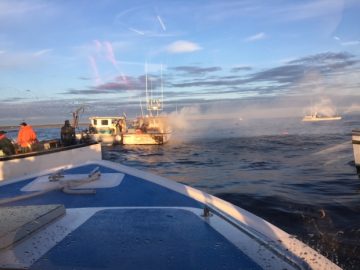 About 15-20 fishing boats rushed to the aid of a fellow lobster fisherman when his boat caught on fire Saturday morning about three kilometres off the northeast coast of P.E.I. Joey Hennessey had just left North Lake Harbour on his boat The Lady Jenalee when a fire started in the motor and worked its way to the back of the boat, said fellow fisherman Jeff MacNeill, one of the fisherman who came to Hennessey’s aid. “There were probably 15 or 20 different vessels that rushed right to him,” MacNeill said. Additional images, Read the rest here 17:57
About 15-20 fishing boats rushed to the aid of a fellow lobster fisherman when his boat caught on fire Saturday morning about three kilometres off the northeast coast of P.E.I. Joey Hennessey had just left North Lake Harbour on his boat The Lady Jenalee when a fire started in the motor and worked its way to the back of the boat, said fellow fisherman Jeff MacNeill, one of the fisherman who came to Hennessey’s aid. “There were probably 15 or 20 different vessels that rushed right to him,” MacNeill said. Additional images, Read the rest here 17:57
Trawl fleet fishery needs Alaska’s help
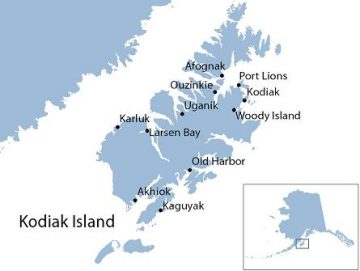 In the next few days, the North Pacific Fishery Management Council, led by a majority of people with no ties to Kodiak and no experience with our fishery, will be making its recommendation about the future of Kodiak and the Gulf of Alaska’s highly successful groundfish trawl fisheries. The Council has already imposed new restrictions on the fishery to reduce the unwanted catch of species like halibut and salmon. Additional management improvements are needed to address these conditions. This is a watershed moment for coastal fishing towns like Kodiak, King Cove and Sand Point. As a recently released economic study makes abundantly clear, Kodiak and the Gulf of Alaska trawl fisheries have contributed significantly, not just to the economy of Kodiak and the Gulf communities, but also to the state’s economy. Read the rest here 17:13
In the next few days, the North Pacific Fishery Management Council, led by a majority of people with no ties to Kodiak and no experience with our fishery, will be making its recommendation about the future of Kodiak and the Gulf of Alaska’s highly successful groundfish trawl fisheries. The Council has already imposed new restrictions on the fishery to reduce the unwanted catch of species like halibut and salmon. Additional management improvements are needed to address these conditions. This is a watershed moment for coastal fishing towns like Kodiak, King Cove and Sand Point. As a recently released economic study makes abundantly clear, Kodiak and the Gulf of Alaska trawl fisheries have contributed significantly, not just to the economy of Kodiak and the Gulf communities, but also to the state’s economy. Read the rest here 17:13
Is there a monster killer shark on the loose off Perth?
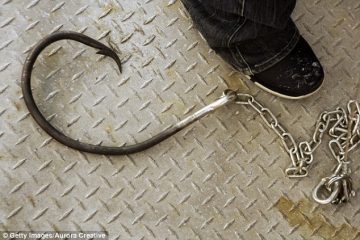 A fisheries drum line hook was snapped by a giant sea creature the day after British diver Doreen Collyer was killed, sparking fears that a monster shark is on the loose off Perth’s coastline. Tony Cappelluti, Fisheries metropolitan regional manager, said that officers saw part of a drum line set off Mindarie submerge at about 3.15pm on Monday, before confirming that the hook had been snapped in half. ‘The hooks being used are the same as those used during research tagging operations that have successfully caught large sharks greater than five metres,’ he told The West Australian. Read the rest here 15:40
A fisheries drum line hook was snapped by a giant sea creature the day after British diver Doreen Collyer was killed, sparking fears that a monster shark is on the loose off Perth’s coastline. Tony Cappelluti, Fisheries metropolitan regional manager, said that officers saw part of a drum line set off Mindarie submerge at about 3.15pm on Monday, before confirming that the hook had been snapped in half. ‘The hooks being used are the same as those used during research tagging operations that have successfully caught large sharks greater than five metres,’ he told The West Australian. Read the rest here 15:40
Overharvest means changes coming to Louisiana blue-crab fishery
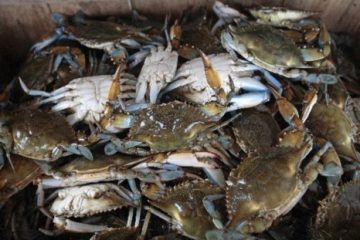 Most bays and tidal lakes in Louisiana these days look like obstacle courses, where the first boater to make it across without wrapping a crab-trap line in his prop wins. Hard to believe that less than half a century ago, the crab trap hadn’t yet been invented. Now, they’re more prevalent in state marshes than mosquitoes. All those wire cages mean it’s getting harder for female crabs to run the gauntlet and make it to the salty waters of the coast to lay their eggs. As a result, Louisiana has seen a concerning decline in its blue-crab population, according to Jeff Marx, a crustacean biologist with the Louisiana Department of Wildlife and Fisheries. Marx has spent two of the last 10 days explaining to two different boards the challenges currently facing Louisiana’s crab population. The first presentation was to the Louisiana Wildlife and Fisheries Commission, the regulatory board that ultimately will make decisions on how to attack the problem. The second was to the state’s blue-crab task force, which serves as a policy liaison between the department and crabbers in the field. Read the rest here 15:11
Most bays and tidal lakes in Louisiana these days look like obstacle courses, where the first boater to make it across without wrapping a crab-trap line in his prop wins. Hard to believe that less than half a century ago, the crab trap hadn’t yet been invented. Now, they’re more prevalent in state marshes than mosquitoes. All those wire cages mean it’s getting harder for female crabs to run the gauntlet and make it to the salty waters of the coast to lay their eggs. As a result, Louisiana has seen a concerning decline in its blue-crab population, according to Jeff Marx, a crustacean biologist with the Louisiana Department of Wildlife and Fisheries. Marx has spent two of the last 10 days explaining to two different boards the challenges currently facing Louisiana’s crab population. The first presentation was to the Louisiana Wildlife and Fisheries Commission, the regulatory board that ultimately will make decisions on how to attack the problem. The second was to the state’s blue-crab task force, which serves as a policy liaison between the department and crabbers in the field. Read the rest here 15:11
































